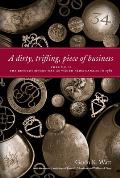|
A New Life
Like their husbands, the women of the Provincial Corps left the new United States to settle in parts unknown to them. They settled in Jamaica, in England, in Abaco, in Bermuda, but mostly they settled in what is now modern Canada.
This piece will close with the words of Mary FISHER, wife of Lodewick FISHER of the 4th Battalion, New Jersey Volunteers. In her own words she describes the voyage to what is now New Brunswick (while the regiment was still serving) and their subsequent harsh first winter in what would be their new home.
She is certainly representative of the great exertions made and the heavy losses suffered by Loyalist families during the American Revolution.
We sailed from New York in the ship Esther with the fleet for Nova Scotia. Some of our ships were bound for Halifax, some for Shelburne and some for St. John's river.
Our ship going the wrong track was nearly lost. When we got to St. John we found the place all in confusion; some were living in log houses, some building huts, and many of the soldiers living in their tents at the Lower Cove.
Soon after we landed we joined a party bound up the river in a schooner to St. Ann's. It was eight days before we got to Oromocto. There the Captain put us ashore being unwilling on account of the lateness of the season, or for some other reason, to go further. He charged us each four dollars for the passage.
We spent the night on shore and the next day the women and children proceeded in Indian canoes to St. Ann's with some of the party; the rest came on foot.
We reached our destination on the 8th day of October [1783], tired out with our long journey, and pitched our tents at the place now called Salamanca, near the shore. The next day we explored for a place to encamp, for the winter was near and we had no time to lose.
The season was wet and cold, and we were much discouraged at the gloomy prospect before us. Those who had arrived a little earlier had made better preparations for the winter; some had built small log huts. This we could not do because of the lateness of our arrival.
Snow fell on the 2nd day of November to the depth of six inches. We pitched our tents in the shelter of the woods and tried to cover them with spruce boughs. We used stones for fireplaces. Our tents had no floor but the ground.
The winter was very cold, with deep snow, which we tried to keep from drifting in by putting a large rug at the door. The snow, which lay six feet around us, helped greatly in keeping out the cold.
How we lived through that awful winter I hardly know. There were mothers, that had been reared in a pleasant country enjoying all the comforts of life, with helpless children in their arms. They clasped their infants to their bosoms and tried by the warmth of their own bodies to protect them from the bitter cold.
Sometimes a part of the family had to remain up during the night to keep the fires burning, so as to keep the rest from freezing. Some destitute people made use of boards, which the older ones kept heating before the fire and applied by turns to the smaller children to keep them warm.
Many women and children, and some of the men, died from cold and exposure. Graves were dug with axes and shovels near the spot where our party had landed, and there in stormy winter weather our loved ones were buried. We had no minister, so we had to bury them without any religious service, besides our own prayers.
The first burial ground continued to be used for some years until it was nearly filled. We called it The Loyalist Provincials Burial Ground.26
43 Peter Fisher, The First History of New Brunswick (Saint John, N.B. 1921), 126-127.
Thanks to Kathryn Hilder of the University of New Brunswick (Fredericton) for her help in obtaining Mary Fisher's account, as well as to Lt. Col. Donald Londahl-Smidt (USAF-retd.), Fellow of the Company of Military Historians, for many of the references used. Likewise the support of the William L. Clements Library, University of Michigan, is gratefully acknowledged for the use of many of their documents in the preparation of this work.

Click here for ---> Female Ancestors Main Page
Refugees & Others: Loyalist Families
Part 1 - Introduction
Part 2 - Those Left Behind
Part 3 - A Variety of Hardships
Part 4 - The Women Join Their Husbands
Part 5 - Services of the Women
Part 6 - Problems in Camp
Part 7 - Widows & Orphans
Top of Page

The On-Line Institute for Advanced Loyalist Studies
For information please contact Todd Braisted
Site maintenance and hosting courtesy of Brandwares.
Copyright Restrictions Document Formatting Optimal Viewing
|



 by Angela Elwell HuntHardcover
by Angela Elwell HuntHardcover